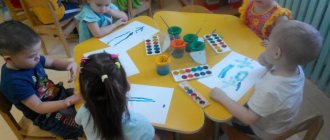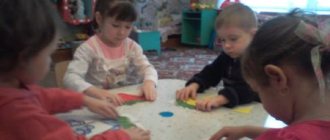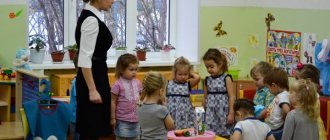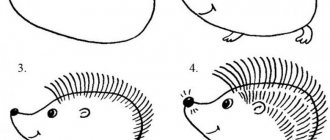Summary of educational activities for drawing in the junior mixed-age group “Brown Bear”
Maria Gamayunova
Notes on drawing in the junior mixed-age group “Brown Bear”
Goals: mastering a new way of depicting - drawing with a foam sponge .
Educational: teach children to depict objects in an unconventional way (with a foam sponge)
; consolidate the ability to depict the shape of parts, their relative size, location, color.
Educational: develop children's creative imagination, create conditions for the development of creative abilities.
Educational: cultivate goodwill, kindness; the ability to see beauty in the simple and ordinary.
A sample of a finished drawing of a bear , an outline of a bear on a landscape sheet , a toy - a small teddy bear , pictures with koala, grizzly, polar bear bears , foam sponges, cotton swabs, gouache (brown, black, red)
napkins, coloring pages with pictures
of bears .
Self-analysis of the teacher
The purpose of the GCD was to introduce the content of an excerpt from Z. Alexandrova’s poem “My Bear”, to continue to teach how to ask and answer questions; promote speech activation; strengthen the ability to draw straight lines, work with paints, and hold a brush correctly.
Tasks:
- familiarization with the content of an excerpt from Z. Alexandrova’s poem “My Bear”;
- activate children's speech, teach them to ask and answer questions;
- strengthening the ability to draw straight lines, hold a brush correctly and work with paints.
All theoretical material was selected taking into account the age of the children, is accessible and scientifically based.
The lesson was conducted without deviations from sanitary and hygienic norms and rules, in compliance with the safety of children.
The visualization I used helped the children learn the proposed material, and helped me fully implement the assigned tasks.
The principle of connecting theory with practice in this lesson was implemented using techniques: the use of visualization, activating questions, and practical actions of children.
During the educational activity, I used a change of types of activities: the children first studied at the tables, then played the outdoor game “A teddy bear walks through the forest” and again continued to study at the tables.
Thus, as a result of direct educational activities, the set goal was achieved, because all the tasks were successfully completed, the children really liked this form of educational activity, and they willingly got involved in the work.
Author: Beldy Victoria Yuryevna, teacher of the Municipal Educational Institution “Kindergarten of the village of Sinda”, Nanaisky district, Khabarovsk Territory, Russia
The article is published in the author's edition
On the topic: methodological developments, presentations and notes
Summary of educational activities with children of the 1st junior group on the topic: “Bear visiting the children.”
Fix the size and primary colors (Blue, yellow, red, green).
Abstract of NNOD on sensory development in the early age group “Teddy bear” Topic of the lesson: “Teddy bear”. Purpose of the lesson: To consolidate the values and primary colors (Blue, yellow, red, green.) Programmatically.
Notes on art activities in the second junior group on the topic: “Teddy bear.”
It is extremely important to pay special attention to the speech development of children aged 3-4 years. Promote the development of coherent speech as a means of communication, enrich active vocabulary. Development is curious.
Drawing lesson for the younger group using the poking method.
Goal: · teach children to draw a bear along the contour with a poke; · consolidate knowledge of colors (brown, black); ·.
Source
On the topic: methodological developments, presentations and notes
Summary of an open lesson on drawing in a non-traditional way (poke drawing + emerging drawing) middle group “Animals of our zoo.” compiled by Kuznetsova Svetlana Vladimirovna Put.
Goals:1. Learn to convey in a drawing the characteristic features of a birch (white trunk with black spots, thin curved branches, light crown), autumn color of foliage.2. Teach children to draw in non-traditional ways.
Summary of a lesson on art activities (non-traditional drawing with elements of appliqué) in the nursery group “Herringbone” Chernikova Valentina Petrovna. Goals: To introduce children to non.
With the help of paintings by great artists, develop the child’s imagination and spiritual world. Develop thinking and creativity. Understanding the world around us through works of art.
Develop an aesthetic perception of nature in the images of literary works and artistic creativity. Learn to draw a birch in an unconventional way - the “poke” method.
Winter miracle snowflakeDrawing in an unconventional technique (drawing with cotton swabs using the “poke” method) Purpose: To learn to use an unconventional technique in work - drawing with cotton wool.
Goals:1. Learn to convey in a drawing the characteristic features of a birch (white trunk with black spots, thin curved branches, light crown), autumn color of foliage.2. Teach children to draw in non-traditional ways.
Source
Goals:
Educational:
- development in children of specific ideas about the properties of dry and wet sand. sand
— development of tactile-kinesthetic sensitivity;
— stabilization of the emotional background; relieving psycho-emotional and physical stress;
- development of curiosity, perseverance.
— improvement of coordination of movements, fine motor skills, orientation in space;
Developmental:
— continue to develop children’s coherent speech and enrich their vocabulary;
— development of tactile-kinesthetic sensitivity;
— development of the ability to act according to verbal instructions;
— development of spatial orientation;
- development of involuntary attention, coordination of movements, fine motor skills.
Educational:
- cultivate a friendly attitude towards others;
- cultivate interest in the features of water and sand;
- cultivate curiosity.
Materials: bear, mini sandbox with sand, watering can with water, buckets and shovels, molds, basin with water, liquid soap, ICT.
Lesson content:
The children are going for a walk. At this time, a sad bear comes to the children's group. The teacher asks the bear why he is sad. Mishka replies that he really wants to play with the kids, but there is no one in the kindergarten, all the kids are out for a walk. The teacher invites the bear to go for a walk with the children.
Children go for walks and come to the sandbox.
Educator: Look, children, this is sand. Let's touch it. What kind of sand is it - dry, light, warm. You can sculpt different shapes from sand.
The teacher invites the children to make Easter cakes. Children take shovels, molds and buckets and begin to sculpt, but the sand is dry and the “cakes” do not crumble.
Educator: Guys, look, you can’t make Easter cakes out of dry sand. Let's add some water to the sand, the sand will become wet. Touch the sand, what is it like? Dark, wet, cold. Now let’s try to make Easter cakes out of wet sand.
Children and their teacher make Easter cakes.
The teacher invites the children to play the game “Unusual Traces”.
1. “The cubs are coming” - the guys prepared their fists and pressed hard on the sand.
2. “Hares jump” - they hit the surface of the sand with their fingertips, moving in different directions.
3. “Snakes are crawling” - and now with their fingers they made the surface of the sand wavy.
4. “Spiderbugs are running” - the guys move all their fingers, imitating the movement of insects.
Educator: Let's play, well done. Our walk has come to an end, we return to the group. Look, kids, how dirty our hands are after playing with sand. You need to wash them with soap and water.
The children and the teacher wash their hands with soap, the bear is sad again.
Educator: The bear is sad again. Maybe we can sing him a song?
Children answer: yes.
Children, together with the teacher, sing the song “Teddy Bear”.
The bear stops being sad and remembers that it’s high time for him to go home to his mother bear. The children and the teacher say goodbye to the bear.
Preview:
Municipal preschool educational institution
Kindergarten No. 16 “Rodnichok”
Summary of a drawing lesson in the younger group.
Educator: Dautova V.Kh.
- teach children to draw a bear along the outline with a poke;
- consolidate knowledge of colors (brown, black);
- instill an interest in drawing;
- teach to find similarities with a toy;
- receive emotional satisfaction from work.
Demonstration material: sample of a finished drawing of a bear; outline of a bear on a landscape sheet; plush bear toy
Handout: landscape sheets with a finished outline of a bear; brushes on a stand, black and brown gouache, napkins; aprons.
There is a knock on the door, the teacher comes in and brings in a large plush toy “Bear” (the bear roars)
Educator: What happened? Dear bear, why aren’t you sleeping?
Little Bear: I was about to go to bed in my den, but suddenly I remembered that I had no friends and I felt very sad.
Guys, who came to us?
Educator: Yes, this is a bear - a clubfooted one! Say hello to him. He lives in the forest. When winter comes, the bear makes a den for itself, where it will sleep all winter until spring. The bear's fur coat is warm, fluffy, and brown. And his nose and eyes are black.
Children look at the bear.
Don’t be sad, bear, we will help you find friends, and you can sleep peacefully in your den until spring. See how children can draw.
I have a friend in my hands for our bear (the teacher shows the finished sample), you will have many equally beautiful and kind friends (addressing the children). Go to your desks. Do you see? There are painted bears on the tables, but the drawings are not finished. Let's make our bears fluffy? Today the brush will work in a special way, jumping up and down. Take your brushes and try to press without paint.
The teacher shows each child the movements of the brush up and down, the children independently repeat the movements on the sheet of paper.
Educator: Well done, you are doing everything right! Now put some brown paint on your brush and start painting along the contour.
The teacher and each child trace the outline of the bear using the poking method, then use the same movements to paint over the entire bear.
Educator: What beautiful and fluffy bears you made! But what else did we forget to draw?
Children: Eyes, noses, mouth.
Educator: Well done! To draw the eyes, mouth and nose, we will take a thin brush and dip it in black paint.
The teacher shows in his drawing. At the end of the work, children place their brushes on stands and wipe their hands with a napkin.
Educator: Look, bear, how many friends you have now! The guys tried very hard to help you (children show their drawings)
The teacher thanks the children on behalf of the bear.
Now you can sleep peacefully in your den, but before you leave, play with us.
Outdoor game “Teddy bear walks through the forest”
Educator: Thank you. Bear, who stayed with us to play! Now it's time for you to go into the forest. Goodbye!
Children say goodbye to the bear.






